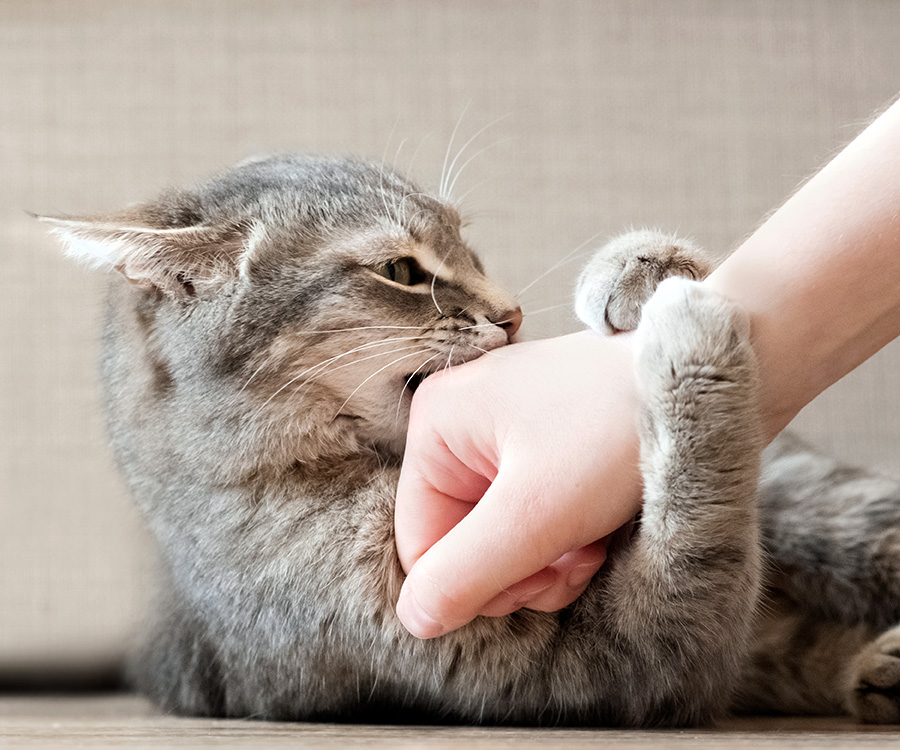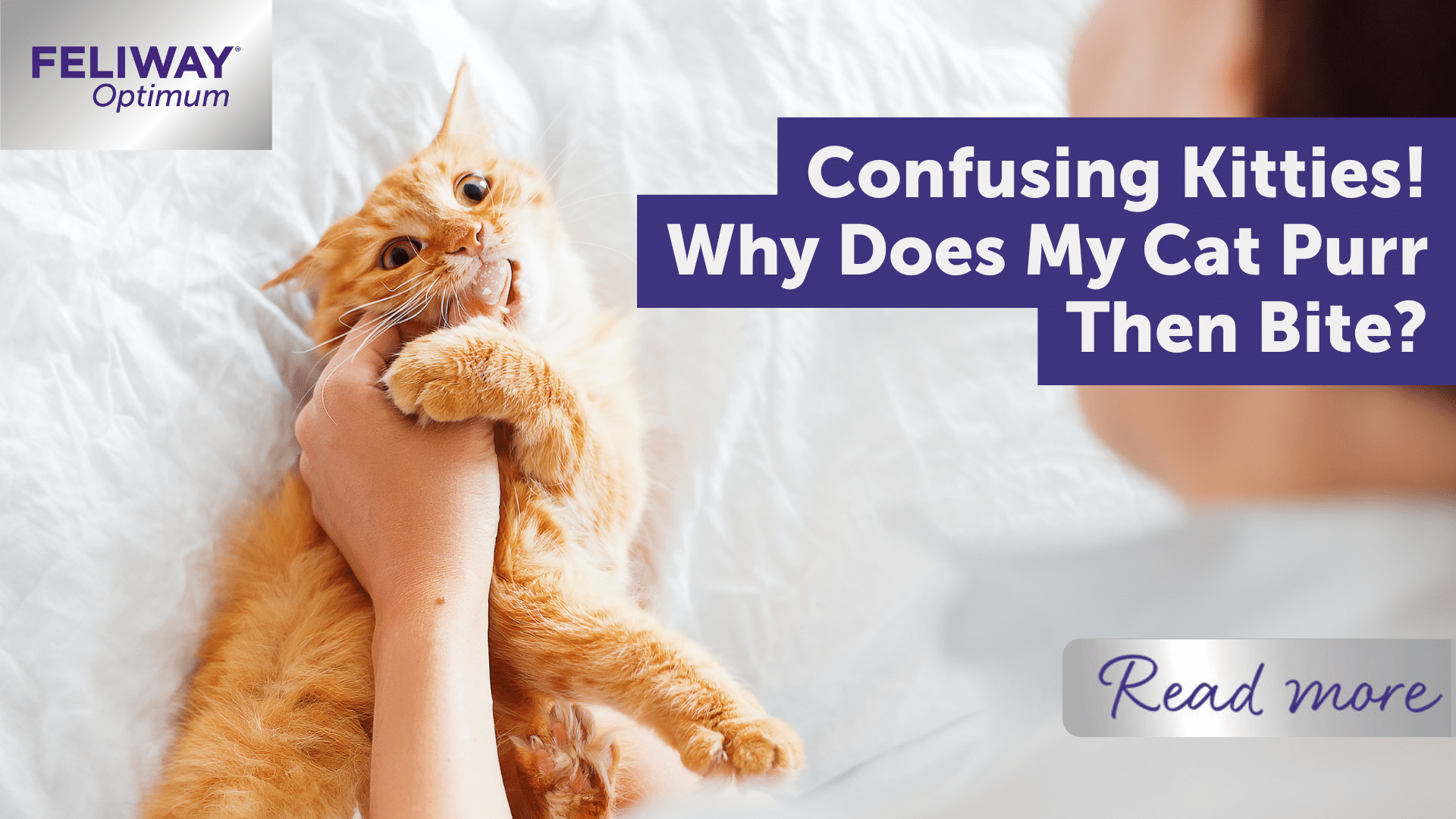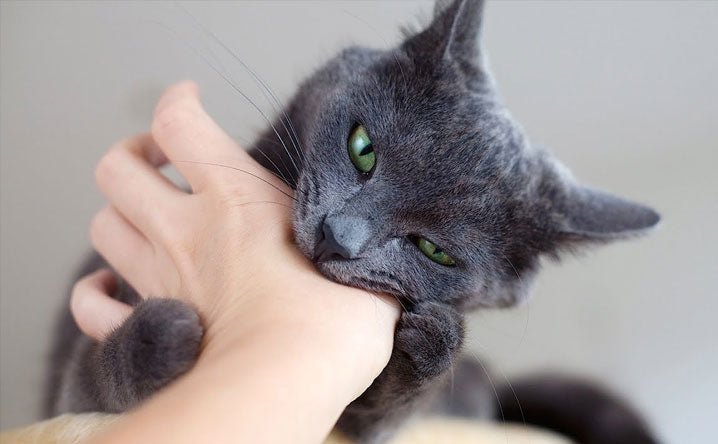Does your cat suddenly switch from purring to biting when you’re giving her a gentle pet? You’re not alone, and you might be wondering why this happens.
Understanding your feline friend’s behavior can be both fascinating and perplexing. Why Is My Cat Biting Me When I Pet Her? Cats have their own unique ways of communicating, and sometimes, a bite is their way of sending a message. By delving into the reasons behind this common behavior, you can transform these unexpected nips into a more harmonious interaction.
Stay with us as we explore the intriguing reasons why your cat might bite when you pet her, and discover how you can foster a deeper connection with your furry companion.

Credit: cats.com
Common Reasons For Cat Biting
Cats might bite during petting due to overstimulation or sensitive areas. They communicate through biting. Understanding their signals helps.
Cats can be mysterious creatures, and their behaviors often leave us scratching our heads. One common conundrum is when your cat starts biting you while you’re petting her. This behavior, while puzzling, is usually rooted in a few understandable reasons. Understanding these reasons can help you create a more harmonious relationship with your feline friend. Let’s dive into the most common reasons why your cat might be biting you during petting sessions. Cats have a threshold for how much petting they can handle. After a certain point, they might feel overstimulated and react by biting. Think of it as your cat’s way of saying, “Enough, please!” Watch for signs like twitching tails or a change in purring. These can indicate she’s reaching her limit.
Playfulness
Sometimes, biting is just a playful gesture. Cats, especially younger ones, often engage in mock hunting. Your hand might resemble a toy or prey in their eyes. Consider using a toy to redirect this playful energy. It can save your hands from those sharp little teeth.
Discomfort Or Pain
Your cat might bite if she’s experiencing discomfort or pain. This could be due to a sore spot or underlying health issue. If biting is accompanied by unusual behaviors, a vet visit might be necessary. It’s always better to err on the side of caution.
Territorial Instincts
Cats are territorial animals. If she feels her space is being invaded or if she’s not in a mood for petting, a bite might be her way of asserting boundaries. Respect her space by giving her a break. You’ll find she appreciates the gesture and might come back for affection on her own terms.
Communication
Your cat might be trying to communicate something. A bite can be a signal of needing something — maybe food or a change in environment. Keep an eye on her overall behavior. This can provide clues about what she might need or want.
Stress Or Anxiety
Stress can lead to unexpected behaviors, including biting. Changes in the environment or routine can trigger anxiety in cats. Create a calm, stable environment for her. Familiarity can help reduce stress and biting incidents. Understanding these common reasons can transform your relationship with your cat. Have you noticed any specific triggers for your cat’s biting? Addressing them can lead to a happier, more peaceful petting experience.
Overstimulation
Many cat owners face a puzzling behavior: their cats bite when petted. This unexpected reaction often stems from overstimulation. Cats have sensitive bodies, and petting can sometimes overwhelm them. Understanding this can help improve your interaction with your feline friend.
Signs Of Sensory Overload
Cats give subtle signs before biting. Watch for twitching tails, flattened ears, or dilated pupils. These indicate your cat is nearing its limit. Sudden hissing or growling also signals discomfort. Recognizing these signs can prevent unwanted behavior.
How To Prevent Overstimulation
Start by petting your cat gently. Short, light strokes are best. Limit petting sessions to a few minutes. Pause if your cat shows signs of distress. Offer breaks between sessions to let your cat relax. Respect their boundaries to maintain a happy relationship.
Provide toys and activities to engage your cat’s mind. This reduces the chance of overstimulation. Use interactive toys that mimic prey. These distract and entertain your cat. A well-exercised cat is less likely to react negatively.
Communication And Boundaries
Cats have their unique way of communicating. Sometimes, this leads to confusion when they bite while being petted. Understanding their signals can help us respect their boundaries. This fosters a stronger bond between you and your feline friend.
Understanding Cat Signals
Cats use body language to express feelings. Watch their tail. A twitching tail often means irritation. Ears are another signal. Flattened ears can indicate discomfort or annoyance. Pay attention to their eyes. Dilated pupils may signal excitement or fear.
Recognizing these signals helps you understand your cat better. It can prevent unwanted biting during petting sessions. Learn the subtle signs your cat shows. This will enhance your interaction and build trust.
Respecting Personal Space
Every cat has personal space needs. Some enjoy long petting sessions. Others prefer short, gentle strokes. Respect your cat’s comfort zone. If they pull away, give them space. This shows you respect their boundaries.
Allow your cat to initiate contact. Let them approach you for affection. This makes them feel secure and understood. Creating a safe environment encourages positive interaction. It reduces stress and unwanted biting.
Playful Behavior
Cats often bite when being petted due to overstimulation. Their sensitive skin can become overwhelmed with too much contact. Understanding these signals can help prevent unexpected nips during cuddle time.
Cats often bite during petting due to playful behavior, a natural instinct that can sometimes be misunderstood. This playful nipping is a way for your feline friend to interact and engage with you. However, it’s important to identify the difference between playful biting and aggression to ensure a happy and healthy relationship with your cat.
Distinguishing Play From Aggression
Cats may bite as part of their play, mimicking hunting behaviors. Look for body language cues like relaxed ears, a playful stance, and purring. These signals indicate that your cat is engaging in fun, not showing aggression. On the other hand, if your cat’s ears are flattened, tail is flicking, or fur is standing up, these are signs of irritation. It’s crucial to stop interaction and give your pet some space to prevent escalating the situation.
Safe Play Techniques
Encourage safe play by using toys instead of your hands. Wand toys, feathers, or laser pointers can be excellent choices to redirect your cat’s energy. This keeps the playtime enjoyable and prevents accidental scratches or bites. Create a play schedule to ensure your cat gets enough physical and mental stimulation. Regular play sessions help reduce the likelihood of your cat biting out of boredom or pent-up energy. Engaging in safe play strengthens your bond while respecting your cat’s natural instincts. Have you ever noticed your cat biting more when you pet her in a particular spot? Understanding your cat’s preferences can make a big difference. Pay attention to her reactions and adjust your petting techniques accordingly for a more enjoyable experience for both of you.
Fear Or Anxiety
Cats bite during petting due to fear or anxiety. Their sensitive nature can trigger discomfort. Understanding their behavior helps in reducing stress-induced biting.
Cats often bite when they feel scared or anxious. Understanding this behavior helps strengthen your bond. Fear or anxiety can arise from many things. A sudden noise, unfamiliar surroundings, or even past trauma. Each cat is unique. Their reactions can vary greatly.
Identifying Anxiety Triggers
Observe your cat to find what triggers her anxiety. Notice her behavior before she bites. Does she bite after a loud sound? Or perhaps during a change in her environment? Identifying these triggers is crucial. It allows you to address the root cause. Keep a journal of her behavior. This helps in spotting patterns. Consult a vet if needed. They can offer professional insight.
Creating A Calm Environment
A calm environment reduces anxiety in cats. Start by ensuring a quiet space for her. Minimize loud noises and sudden movements. Provide hiding spots for your cat. Cats feel secure with places to retreat. Regular routines can also help. Feed and play with her at the same times daily. This predictability reduces stress. Consider using calming pheromone diffusers. They promote relaxation and comfort.

Credit: www.hartz.com
Medical Issues
Cats may bite while being petted due to overstimulation or discomfort. Understanding feline body language can help prevent bites. Always watch for signs your cat wants a break.
Have you ever been enjoying a peaceful moment with your cat, only to have it suddenly interrupted by a sharp bite? It’s frustrating and puzzling, right? One reason your cat might bite when you pet her is due to underlying medical issues. Cats, much like humans, can experience pain and discomfort that may cause them to react defensively. Understanding these medical concerns is crucial to improving your furry friend’s well-being and your relationship with her.
Pain And Discomfort
Cats are masters at hiding their pain. Yet, when it comes to petting, certain touches might trigger discomfort. Imagine having a sore arm and someone unknowingly squeezes it. You’d react, wouldn’t you? Cats do the same. A simple touch can irritate an existing injury or a sore spot. Whether it’s arthritis in older cats or a recent trauma, pain can manifest in biting. Pay attention to where your cat bites. Is it when you touch her back or tail? Identifying these areas can provide clues to any underlying issues.
When To Consult A Veterinarian
So, when should you call in the professionals? If your cat bites consistently when pet in certain areas, it’s time to consult a vet. Your vet can perform a thorough examination to rule out or diagnose medical conditions. This proactive step is essential for your cat’s health and your peace of mind. Consider the frequency of these episodes. Are they becoming more common? If yes, it’s better to seek advice sooner rather than later. Moreover, if you notice other changes in behavior, such as limping or withdrawal, these might be linked to the biting incidents. Have you ever had a sudden toothache that changed your mood? Cats experience similar shifts, emphasizing the need for a vet’s expertise. By addressing medical issues promptly, you can improve your cat’s comfort and reduce biting. It’s all about understanding her needs and ensuring she’s happy and healthy.
Building Trust And Comfort
Building trust and comfort with your cat is essential. It helps reduce biting during petting. Cats have unique personalities. Some may feel threatened or overstimulated. Understanding their behavior creates a peaceful bond. You can start by establishing a routine and using positive reinforcement strategies. These methods foster trust and comfort. They also help your cat feel safe and loved.
Establishing A Routine
Cats thrive on routine. They feel secure with predictable patterns. Set regular times for feeding and play. This helps your cat know what to expect. It reduces anxiety. Consistent petting sessions can also help. Your cat learns that petting is positive. This builds trust over time. Stick to a routine. Your cat may feel more comfortable and less likely to bite.
Positive Reinforcement Strategies
Rewarding good behavior encourages trust. Use treats or gentle praise. This reinforces positive interactions. When your cat allows petting without biting, reward her. She will associate petting with positive experiences. Keep rewards small and consistent. This makes learning easier. Avoid punishing your cat for biting. Negative reactions can increase fear. Focus on praising calm behavior instead.
When To Seek Professional Help
If your cat bites during petting, it might be time to consult a vet. Sudden aggression can signal pain or health issues. A professional can help identify underlying problems, ensuring your cat’s well-being.
When your cat bites during petting, it may indicate a deeper issue. Some cats bite as a form of play. Others might do it because of discomfort or pain. Understanding when to seek professional help is crucial. A veterinarian can offer insights into your cat’s behavior. They can identify if a health problem exists.
Consult A Veterinarian
Frequent biting may require a vet’s attention. Cats sometimes bite due to medical issues. These issues might cause discomfort or pain. A vet can diagnose health problems. They can suggest treatment or medication. This can help reduce biting behavior.
Behavioral Expert Advice
Some biting is rooted in behavioral issues. A behavior expert can assess your cat. They identify triggers for biting. Experts create a behavior modification plan. This plan can improve interaction with your cat. It reduces stress and enhances bonding.
Signs That Indicate Urgency
Look for signs that need urgent care. These include sudden aggression or changes in behavior. Also, notice changes in appetite or grooming habits. They may signal health concerns. Immediate professional help is necessary. Keep your cat safe and healthy.

Credit: www.feliway.co.uk
Frequently Asked Questions
Why Does My Cat Bite When Petted?
Cats may bite when petted due to overstimulation. Petting can become overwhelming, causing discomfort or irritation. Cats have sensitive areas and may react defensively. It’s important to observe your cat’s body language. Signs like twitching tails or flattened ears indicate they’re reaching their limit.
How Can I Stop My Cat From Biting?
To stop biting, understand your cat’s triggers. Limit petting sessions and avoid sensitive areas. Provide toys for interactive play. Redirect biting behavior to appropriate objects. Offering treats for calm behavior can reinforce positive actions. Consistency is key in training your cat to stop biting.
Is Biting A Sign Of Affection In Cats?
Biting can sometimes be a sign of affection. Cats may give gentle “love bites” during petting. These are usually soft and not aggressive. However, it’s essential to distinguish between playful nips and overstimulation bites. Understanding your cat’s behavior helps in interpreting their actions correctly.
What Should I Do If My Cat Bites Me?
If bitten, remain calm and avoid reacting aggressively. Gently withdraw your hand and give your cat space. Clean the wound with soap and water to prevent infection. Monitor for signs of infection and consult a doctor if necessary. Understanding triggers can prevent future biting incidents.
Conclusion
Understanding your cat’s behavior can improve your bond. Cats bite for various reasons. Sometimes it’s playfulness. Other times, overstimulation or discomfort. Observe your cat’s signals. Tail movements and ear positions are clues. Respond gently to their needs. Patience and care are key.
Ensure your cat feels safe and loved. Adjust your approach if needed. Respect their space and preferences. Consult a vet if biting persists. Professional advice can help. Your relationship with your cat matters. Nurture it with attention and understanding.

